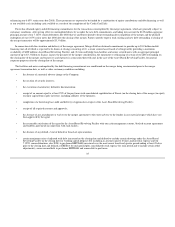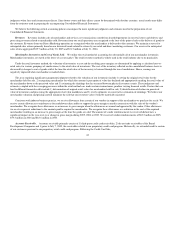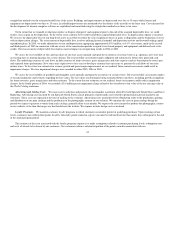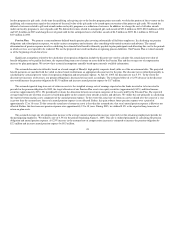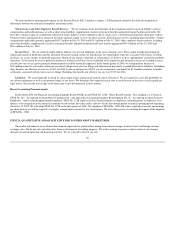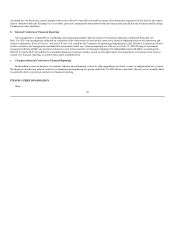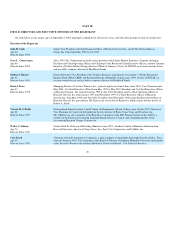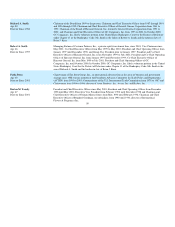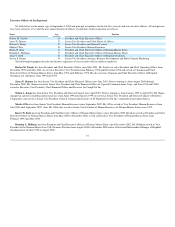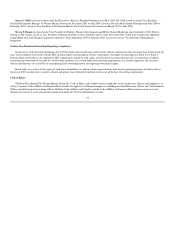Neiman Marcus 2004 Annual Report Download - page 48
Download and view the complete annual report
Please find page 48 of the 2004 Neiman Marcus annual report below. You can navigate through the pages in the report by either clicking on the pages listed below, or by using the keyword search tool below to find specific information within the annual report.
loyalty programs for gift cards. At the time the qualifying sales giving rise to the loyalty program points are made, we defer the portion of the revenues on the
qualifying sales transactions equal to the estimate of the retail value of the gift cards to be issued upon conversion of the points to gift cards. We record the
deferral of revenues related to gift card awards under our loyalty programs as a reduction of revenues. In addition, we charge the cost of all other awards
under our loyalty programs to cost of goods sold. We deferred revenues related to anticipated gift card awards of $23.8 million in 2005, $20.8 million in 2004
and $17.8 million in 2003 and charged costs of goods sold for the anticipated costs of all other awards of $4.9 million in 2005, $6.1 million in 2004 and
$4.9 million in 2003.
Pension Plan. We sponsor a noncontributory defined benefit pension plan covering substantially all full-time employees. In calculating our pension
obligations and related pension expense, we make various assumptions and estimates after consulting with outside actuaries and advisors. The annual
determination of pension expense involves calculating the estimated total benefits ultimately payable to plan participants and allocating this cost to the periods
in which services are expected to be rendered. We use the projected unit credit method in recognizing pension liabilities. The Pension Plan is valued annually
as of the beginning of each fiscal year.
Significant assumptions related to the calculation of our pension obligation include the discount rate used to calculate the actuarial present value of
benefit obligations to be paid in the future, the expected long-term rate of return on assets held by the Pension Plan and the average rate of compensation
increase by plan participants. We review these actuarial assumptions annually based upon currently available information.
The assumed discount rate utilized is based on a broad sample of Moody's high quality corporate bond yields as of the measurement date. The projected
benefit payments are matched with the yields on these bonds to determine an appropriate discount rate for the plan. The discount rate is utilized principally in
calculating the actuarial present value of our pension obligation and net pension expense. At July 30, 2005, the discount rate was 5.5%. To the extent the
discount rate increases or decreases, our pension obligation is decreased or increased, accordingly. The estimated effect of a 0.25% decrease in the discount
rate would increase the pension obligation by $15.0 million and increase annual pension expense by $1.7 million.
The assumed expected long-term rate of return on assets is the weighted average rate of earnings expected on the funds invested or to be invested to
provide for the pension obligation. In 2005, the target allocation of our Pension Plan assets was equity securities (approximately 80%) and fixed income
securities (approximately 20%). We periodically evaluate the allocation between investment categories of the assets held by the Pension Plan. The expected
average long-term rate of return on assets is based principally on the counsel of our outside actuaries and advisors. We utilize this rate primarily in calculating
the expected return on plan assets component of the annual pension expense. To the extent the actual rate of return on assets realized over the course of a year
is greater than the assumed rate, that year's annual pension expense is not affected. Rather, this gain reduces future pension expense over a period of
approximately 12 to 18 years. To the extent the actual rate of return on assets is less than the assumed rate, that year's annual pension expense is likewise not
affected. Rather, this loss increases pension expense over approximately 12 to 18 years. During 2005, we utilized 8.0% as the expected long-term rate of
return on plan assets.
The assumed average rate of compensation increase is the average annual compensation increase expected over the remaining employment periods for
the participating employees. We utilized a rate of 4.5% for the periods beginning August 1, 2005. This rate is utilized principally in calculating the pension
obligation and annual pension expense. A 0.25% increase in the assumed rate of compensation increase is estimated to increase the pension obligation by
$2.3 million and increase annual pension expense by $0.5 million.
45


